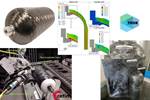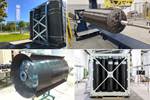OVERLEAF tackles thermoplastics, open cell insulation, sensors and testing for LH2 tank
Newsletter #4 gives latest status on EU project’s work toward thermoplastic composite tanks with 40% storage density of cryogenic hydrogen for future zero emissions aircraft.
Source | OVERLEAF project
is an EU-funded project that aims to develop a game-changing fiber-reinforced thermoplastic composite liquid hydrogen (LH2) storage tank to enable the transition toward H2-powered aircraft and net-zero aviation by 2050. Project coordinator (Miranda de Ebro, Spain) has issued Newsletter #4, summarizing progress and next developments.
The new LH2 storage system features a composite tank operating at 6-bar pressure inside the tank storing LH2 at temperatures in the region of -253°C. OVERLEAF aims to reach an average gravimetric index (GI) — also known as storage density = mass LH2/mass system — of 40%, with an estimated 60% reduction in the total weight/energy consumption and a 25% increase in onboard H2 storage capacity.
Composite materials solutions and advanced automated manufacturing processes are being developed to significantly reduce the overall system’s weight to help reach this high GI. This will also improve the design flexibility of the tanks and their robustness as they are structurally part of the fuselage. Another goal is to significantly reduce cost for commercial aircraft compared to state-of-the-art available H2 storage systems.
OVERLEAF reports nearing its midway point in 2024. Since December 2023, the consortium has made significant strides. Recent meetings in Valencia and Girona provided opportunities to discuss both achievements and challenges. These collaborative sessions have solidified the project’s commitment to manufacturing and testing a demonstrator LH2 storage tank.
OVERLEAF consortium partners. Source | OVERLEAF
In collaboration with Canoe, Aimen, UdG and Aciturri, the OVERLEAF consortium has focused on addressing the disparity in coefficients of thermal expansion (CTE) between the matrix and the fibers, focusing on thermoplastic polymers. This work is deemed crucial to enhancing the structural integrity and performance of the novel storage system.
OVERLEAF has also defined the final open cell material, a pivotal step in optimizing the thermal insulation properties of its tanks. Another significant advancement is development of advanced temperature sensors tailored for use at cryogenic temperatures. These sensors are essential for precise monitoring and management of the thermal conditions within the storage system.
The University de Girona (UdG, Girona, Spain) has conducted the first tests at cryogenic temperatures to determine the structural properties of the thermoplastic composite materials. These tests are foundational to ensuring the robustness and reliability of the LH2 storage solution under operational conditions.
Related Content
-
The potential for thermoplastic composite nacelles
Collins Aerospace draws on global team, decades of experience to demonstrate large, curved AFP and welded structures for the next generation of aircraft.
-
Plant tour: Teijin Carbon America Inc., Greenwood, S.C., U.S.
In 2018, Teijin broke ground on a facility that is reportedly the largest capacity carbon fiber line currently in existence. The line has been fully functional for nearly two years and has plenty of room for expansion.
-
Hybrid process marries continuous, discontinuous composites design
9T Labs and Purdue applied Additive Fusion Technology to engineer a performance- and cost-competitive aircraft bin pin bracket made from compression-molded continuous and discontinuous CFRTP.







